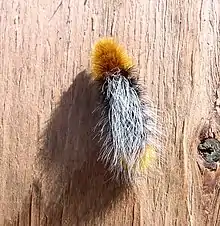Platyprepia
Platyprepia is a monotypic tiger moth genus in the family Erebidae erected by Harrison Gray Dyar Jr. in 1897. Its only species, Platyprepia virginalis, or Ranchman's tiger moth, was first described by Jean Baptiste Boisduval in 1852.[1][2] It is found in western North America, ranging from southern Monterrey Bay in California across Nevada and southern Utah to Colorado and north to southern British Columbia. The habitat consists of wet lowland prairies, wet meadows, wet forests and in riparian zones along creeks in dry desert regions.
| Platyprepia | |
|---|---|
 | |
| From British Columbia, Canada | |
| Scientific classification | |
| Kingdom: | Animalia |
| Phylum: | Arthropoda |
| Class: | Insecta |
| Order: | Lepidoptera |
| Superfamily: | Noctuoidea |
| Family: | Erebidae |
| Subfamily: | Arctiinae |
| Genus: | Platyprepia Dyar, 1897 |
| Species: | P. virginalis |
| Binomial name | |
| Platyprepia virginalis (Boisduval, 1852) | |
| Synonyms | |
| |
The length of the forewings is 26–31 mm. The forewings are black with numerous light yellow spots. The hindwings are variable in pattern, but are most commonly orange with broad irregular black bands. Adults are on wing in summer.
The larvae feed on a wide range of herbaceous plants. They are covered with dense long hairs. These hairs are orange at the head and tail and black in the central part.[3]

References
- Savela, Markku. "Platyprepia Dyar, 1897". Lepidoptera and Some Other Life Forms. Retrieved August 8, 2019.
- "930289.00 – 8163 – Arctia virginalis – Ranchman's Tiger Moth – (Boisduval, 1852)". North American Moth Photographers Group. Mississippi State University. Retrieved August 8, 2019.
- Pacific Northwest Moths
| Wikispecies has information related to Platyprepia. |
| Wikimedia Commons has media related to Platyprepia. |
External links
- Pitkin, Brian & Jenkins, Paul. "Search results Family: Arctiidae". Butterflies and Moths of the World. Natural History Museum, London.
- Balaban, John; Balaban, Jane (March 13, 2017). "Species Platyprepia virginalis - Ranchman's Tiger Moth - Hodges#8163". BugGuide. Retrieved August 8, 2019.